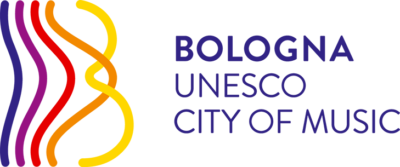From 2001 to 2010: rock and pop change rules
Internet and globalization were arriving, in music too. After a decades-long itinerary, Bologna felt the need to examine itself and rediscover its way ahead.
The newly opened millennium was to overturn many fixed ideas in music. The mp3 format was born in 1991 and in 1999 it was the turn of Napster. Digital technology was increasingly consolidated in the production process, but the new peer-to-peer services facilitated piracy, undermining the entire musical world.
This evident acceleration, which affected the musical world and even the themes it dealt with, disoriented the public and the industry. On 23rd October 2001, Apple presented the first iPod; iTunes, the first virtual shop, arrived in 2003 and traditional sales of discs began a slow but inexorable decline that was to result, over the next fifteen years, in a 40% loss of revenue.
The 2000s opened to a new musical system and an emerging movement of groups that echoed through the city: Settlefish, Joycut, Bologna violenta, Ofeliadorme, Rude Pravo and Germano Bonaveri, to mention only a few.
Umberto Maria Giardini, whose stage name was Moltheni, was from the Marche but Bolognese by adoption. After his first album “Natura in replay”, he came to the fore during the 2000 Festival di Sanremo with “Nutriente”. Beatrice Antolini, like Moltheni, made Bologna her “own” city. A producer and multi-instrumentalist, she made her debut in 2006 with the album “Big Saloon”, followed by “Adue”, “BioY”, “Vivid” and “L'AB”. Her own works were joined by collaborations and heterogeneous participations.
After winning the Roxy Bar trophy, the Estranea published their debut album “Direzione Estranea” in 2001 for the Sugar label. The Diva Scarlet, born as the Skummer, published their album “Apparenze” in 2004.
The Cut were formed in Bologna in 1996. The image that best represents them is that of the UK webzine Pennyblack Music, which described them as “John Lee Hooker in a post punk straitjacket”. Their activity was essential for the birth of the independent Bolognese label Gamma Pop, which also handled One Dimensional Man, Julie's Haircut and Giardini di Mirò. Their first album, “Operation Manitoba”, came out in 1998. It marked the beginning of a dedicated career, in the studio and live, which broke Italian and European confines.
The Bolognese hip-hop movement remained highly active. The Porzione Massiccia Crew collective, created in 1995 by the rapper Inoki, Gianni KG and the writer Paniko, made its musical debut in 1998 with its first mixtape, “Demolizione 1”. Taking part were also Fabri Fibra, Deda and DJ Lugi. In 2004, they published “PMC vs Club Dogo - The Official Mixtape”, in collaboration with the Club Dogo of Gué Pequeno, Jake La Furia and Don Joe.
The Mariposa were also born at the turn of the new millennium. Their debut album, “Portobello illusioni”, was only the beginning of a long journey, which was to pass through “Domino Dorelli”, “Quanti sedani lasciati ai cani” and “Pròffiti Now! Prima Conferenza Sulla Musica Componibile”, in which Manuel Agnelli, Max Gazzè and Peter Hammill of the Van Der Graaf Generator also took part.
The Locomotiv Club was created in 2007. It offered local, national and international concerts, as did, in a different but complementary manner, the nearby Freakout Club from 2012.
Independent music was vibrant, but did not have an easy life, not least on account of the evolution in youth politics and a rebalance among citizens. This landslide was felt by the Scandellara Rock Festival, a historical Bolognese event organized in the park of that name in the Quartiere San Vitale. It was a stage on which appeared Alix, Magilla, Disciplinatha, Splatterpink, New Hyronya, Silhouette, Gli Avvoltoi, Gli Atroci, EL V and the Garden House, Radio City and Gli Sciacalli. The festival gave a perfect snapshot of the DNA of underground live music in Bologna. Almost 60,000 people attended its concerts, workshops and events every year.
The roBOt Festival, an event dedicated to the interaction between electronic music and the visual arts, was born in 2008. It was organized by the Associazione Culturale Shape in collaboration with various institutions, including the Fondazione del Teatro Comunale and the Accademia di Belle Arti. Each festival was based on a theme and included concerts, workshops, installations and DJ sets, hosting great international names such as Ryūichi Sakamoto, Carl Craig, Jon Hopkins, Yann Tiersen and David Sylvian.
A few years earlier, Lucio Dalla had explored a new aspect of his artistic odyssey, creating the modern opera “Tosca Amore Disperato”, inspired by Giacomo Puccini’s “Tosca”. His commitment to the Bolognese theatre was renewed when he collaborated with the Teatro Comunale for the theatrical direction of Igor Stravinsky’s “Pulcinella” and Ferruccio Busoni’s “Arlecchino”.
On 25th February 2008, Gianni Morandi opened the Festival di Sanremo singing Domenico Modugno’s “Nel blu dipinto di blu”, 50 years after the festival that had made the author an undisputed icon of Italian song. The positive results of this intense activity from 2007 to 2009 had an important effect on Morandi: in 2011 and 2012 he was the presenter of the Festival di Sanremo.
Listen to the playlist

